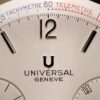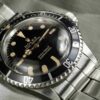Grand Feu Enamel Dials: Secrets of Craftsmanship and How to Spot a Fake

Enamel dials are among the most admired achievements in watchmaking. Their brilliance, depth, and resistance to fading give them a timeless beauty that no paint or lacquer can replicate. At the same time, because of their rarity and desirability, they are also among the most counterfeited features in vintage watches. For collectors, being able to distinguish a genuine enamel dial from a lacquered or resin reproduction is essential. This article explores the secrets of Grand Feu enamel dials, their production process, and the key signs that help identify original examples versus fakes.
Grand Feu Enamel Dial Secrets
“Grand Feu” — literally “great fire” — is one of the most prestigious techniques in classical dial making.
It derives its name from the dramatic burst of flame that can appear when alcohol used to bind the enamel powder ignites as the dial enters the kiln. At its core, enamelling is the art of fusing finely ground glass — a mix of silica, fluxes, and metal oxides — onto a metal base through repeated firings at very high temperatures.
The result is a vitreous, glassy surface of exceptional durability. Unlike paint or lacquer, the colour is embedded in the glass itself and will not fade or tarnish with time.


The process begins with a blank plate, often made of copper, gold, or a specific alloy.
The blank is meticulously cleaned with acid baths and ultrasonic rinsing to remove dust, oils, or contaminants that could create imperfections. In some workshops, the edges are slightly curled or flanged to prevent molten enamel from flowing off during firing.
(picture courtesy of Adriano Davidoni)
The enamel, in powder form, is evenly sieved across the surface.
To keep the powder stable when moving the blank to the kiln, artisans lightly mist it with alcohol or binder.
In certain traditions, this alcohol ignites as the dial enters the kiln, creating the “great fire” effect. The kiln is heated to between 700 °C and 900 °C.
In just a few minutes, the powder melts and fuses with the metal. The dial is cooled, inspected, and if successful, the process is repeated.
This layering typically requires 6 to 8 firings to achieve the desired thickness, colour depth, and uniform surface.
Once the enamel body is complete, the dial is trimmed to its final dimensions. Holes for the hands are cut using diamond tools under water lubrication to avoid cracking, and subdials, if present, are separately enamelled and then countersunk (picture courtesy of Adriano Davidoni)


To avoid warping, most high-quality enamel dials also receive counter-enamel (contre-émail): a thin enamel layer on the reverse side of the plate. This balances stresses during firing and is a key feature of many genuine dials.
Decoration comes last. Numerals, scales, and logos are usually applied through pad-printing (décalque), where enamel-based inks are stamped and fired, fusing them permanently into the surface. In high-art pieces, details may also be hand-painted by brush. Because these markings are fired, they are effectively permanent and cannot be removed by solvents.
Unlike applied metal indexes, enamel inscriptions are smooth, integrated, and unerasable. The prime virtue of Grand Feu enamel is that it does not age like paint or lacquer. White remains white, colours stay vivid. But enamel is brittle: if cracked or chipped, it cannot be repaired. For this reason, many historic pieces have replacement enamel dials, often remade by modern artisans
(picture courtesy of Adriano Davidoni)
Recognising an Original Enamel Dial
When examining a vintage watch, especially from brands like Patek Philippe, Vacheron Constantin, or Longines, knowing the hallmarks of a genuine enamel dial is critical.
a note: on this post, all square pictures refer to NON ORIGINAL dials

1. Surface Hardness & Reflectivity
A true enamel dial has a cold, glass-like feel. The surface may be glossy or matte, but it always reflects light crisply and with depth. Under magnification, it is smooth and flawless. Painted or lacquered dials often show brush marks, micro-cracks, or blurred reflections.


2. Counter-Enamel on the Reverse
Check the back. Many enamel dials show counter-enamelling, often in a darker or uneven layer. Its presence helps confirm authenticity. If the back is plain brass or copper, caution is warranted — though some early dials lacked counter-enamel.
3. Recess Depth & Engraved Subdials
Original enamel dials often have recesses carved into the blank for subdials or registers before enamelling. The enamel then flows into these cavities seamlessly. In fakes, subdials may look flat, shallow, or painted on.
4. Sharpness of Graphics
On genuine dials, graphics are fired into the enamel itself. They will not peel or flake. If inscriptions look like they sit “on top” of the surface, or if they are faint and easily worn, this may indicate cold paint.


5. Sterile Dials and Retailer Signatures
In the 1920s and 1930s, it was common for dials to be delivered sterile — without brand names — and later personalised by retailers. These signatures were applied in cold paint, not enamel. Over time, they may fade or wear. Such dials can still be original, but comparison with other period examples is essential to confirm consistency.
6. Absence of Patina or Yellowing
Enamel does not oxidise or yellow. A vintage enamel dial should retain its original brightness. If you see patina, spotting, or discoloration typical of paint, it is almost certainly not enamel.
7. Edge Quality
Genuine enamel dials sit flush and show fine, sharp edges. Poorly fitting dials, chips, or uneven cuts may indicate replacements or imitations.


8. Dial feet
In many original enamel dials, the dial feet are integrated into the enamel structure in a way that gives the impression they “emerge” from the dial surface—almost as though they are breaking out of the enamel.
Because the enamel is built up layer by layer and the feet are often part of the dial blank before enamelling, the enamel flows around and fuses to the base of the feet, creating seamless continuity between foot and dial.
By contrast, in many aftermarket dials, the feet are not original to the enamel—but are instead soldered onto the back surface of the dial.
Soldering leaves r traces of solder visible behind the dial, and the junction between foot and dial may look less natural or “added.” Because soldering is a mechanical after-process, it does not reproduce the same structural integration as the original enamel build.
If you see evidence of solder it’s a strong red flag that the dial may not be original. That said, soldered feet do not categorically mean a dial is fake—some original dials may have had restoration repairs. But in combination with other signs (surface texture, printing, enamel integrity, etc.), soldered feet are a significant warning sign against originality of an enamel dial.


9) Resin Dials
Some so-called “enamel-like” dials are in fact made of lacquer or synthetic resin. At first glance they can appear convincing, with a glossy surface that recalls true enamel. However, under close examination their differences become clear.
The surface lacks the compact, glass-like density of enamel and instead feels warmer and softer to the touch. One diagnostic test is the hot pin test: if the edge of the dial is lightly touched with a heated pin, resin will emit a burnt smell and mark like plastic. A true enamel dial, being vitrified glass fused onto metal, cannot burn or melt in this way.
These resin dials are therefore easy to spot once examined carefully, though to the untrained eye they can pass as enamel at a distance. For collectors, recognising the warmer feel, softer reflections, and non-glassy structure of resin is key to avoiding confusion.
10) Laquered dials
Lacquered dials are inexpensive copies and bear no relation to true enamel. Instead of being created through high-temperature firing, they are simply metal bases sprayed or coated with a glossy enamel-like paint.
At a glance they may imitate the shine of enamel, but under examination the differences are clear. The surface lacks depth and compactness, the graphic quality is usually inferior, and printing often appears flat or inconsistent.



These dials are much thinner than genuine enamel dials, as there is no built-up vitreous layer. The reverse is plain bare metal, without counter-enamel or any signs of glass fusion. For the trained eye, these features quickly distinguish lacquered reproductions from authentic fired enamel dials.
Why Enamel Dials Were Counterfeited
Because enamel dials are rare, costly, and desirable, they are frequent targets for forgery. Some fakes are simply lacquered dials designed to mimic enamel’s sheen. Others use resin, which can look glossy but lacks enamel’s hardness. In some cases, counterfeiters apply a thin glass- like layer over a painted dial and sell it as enamel.

Collectors should also be wary of “fantasy” enamel dials — configurations never made by the brand. A historic reference may suddenly appear with an enamel dial in a colour or style never documented. Unless supported by strong provenance, these should be considered suspect.
The Omega dial below is deceiving and has tricked quite a few collectors, the quality of the print is quite good, but the following details allow us to determine it’s not an original:
- the graphics are different from the original dial,
- the dial feet are soldered
- the counters are flat, they are not recessed
- look at the pictures of the Omega dial posted earlier to check some of the differences)



Additional Practical Checks
• Serials and movement matching: Original enamel dials usually align with correct serial ranges.
• Reference history: Verify if the model was ever offered with enamel.
• Dial signature: Pad-printed and fired logos are flush. Raised or removable logos may indicate later printing.
• Consistency with maison practices: Each brand had distinctive styles of enamelling, printing, and reverse finishing. Study these as deviations are warning signs.
Conclusion
Grand Feu enamel dials embody the marriage of art and craftsmanship. Forged in fire, they resist the ageing that affects paint or lacquer, making them highly valued by collectors.
At the same time, their fragility and rarity make them frequent targets of imitation. For the collector, recognising an authentic enamel dial means looking beyond appearances: examining surface texture, checking for counter-enamel, assessing printing integration, and understanding the historical context of the model.
Enamel is not just a style — it is a material, forged in flames. Once you know its secrets, you can appreciate its unique beauty and protect yourself against deception in the vintage market.




